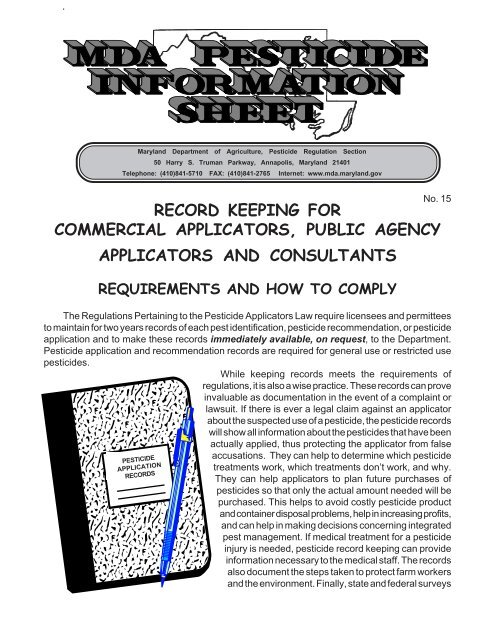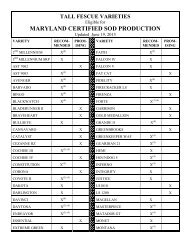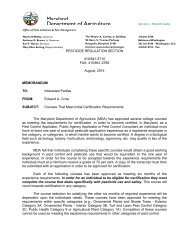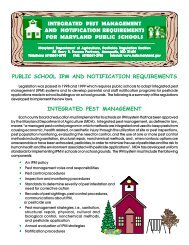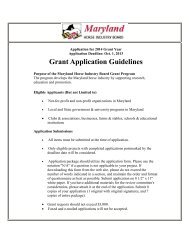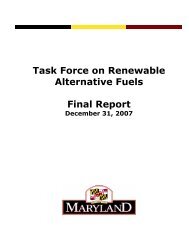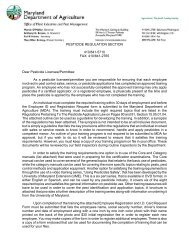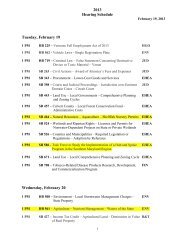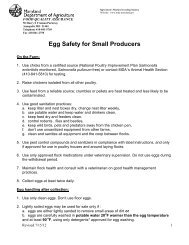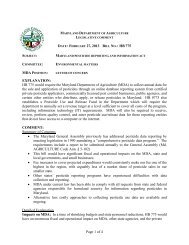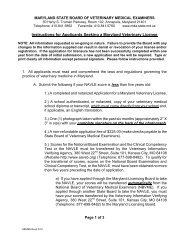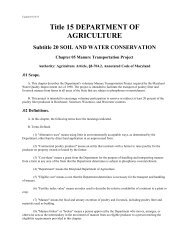Record-Keeping for Commercial & Public Agency Applicators
Record-Keeping for Commercial & Public Agency Applicators
Record-Keeping for Commercial & Public Agency Applicators
Create successful ePaper yourself
Turn your PDF publications into a flip-book with our unique Google optimized e-Paper software.
can often use in<strong>for</strong>mation voluntarily supplied from pesticide records. The data obtained by thesesurveys can help show the safety of and the economic need <strong>for</strong> the use of certain pesticides. Inaddition, the U.S. Environmental Protection <strong>Agency</strong> (EPA), U.S. Department of Agriculture (USDA)and the Maryland Department of Agriculture (MDA) use pesticide survey in<strong>for</strong>mation in determiningbenefits of pesticides being considered <strong>for</strong> reregistration. Without current, accurate records to rely onto generate survey data, it is often difficult to show the benefit of a particular pesticide.The following in<strong>for</strong>mation is required by regulation to be recorded, when applicable:1. Name of applicator or consultant. List the name of the individual who actually per<strong>for</strong>ms thepesticide application, recommendation or pest inspection, rather than the name of the business oragency.2. Date of application, recommendation, or pest identification. List the actual date the pesticidewas applied, recommended, or pest identification was made, rather than the date on which theservice was contracted. If an application to the same general site (i.e., same field or structure) takesmore than one day, then each day’s application should be recorded as a separate record.3. The plant, animal or site to which the pesticide was applied or recommended, and the pestto be controlled. A general description of the plant, animal or site where the pesticide was appliedor recommended <strong>for</strong> use must be made. Oak tree, azalea, sweet corn, tomato are a few examplesof possible plant descriptions that may be treated or <strong>for</strong> which a pesticide recommendation is made.In addition, single family house, apartment, sidewalk, parking lot or ball field are a few examples ofsites where pesticides may be applied or recommended <strong>for</strong> use.4. Acreage, square footage, cubic footage, linear footage, or numbers of plants or animals or adescription of area or structure treated (acreage, square footage or cubic footage should berecorded when label instructions specify these measurements). This in<strong>for</strong>mation should be morespecific than the general description called <strong>for</strong> in item Number 3. As the regulation indicates, whenthe application or recommendation is <strong>for</strong> units such as acres, square footage, cubic footage, or linearfootage they must be recorded. For applications to structures where cubic footage does not apply,then a description of the area of the structure treated must be recorded.5. Address of treated property. For multi-unit structures such as apartments or offices, the addressrecorded must also include the apartment numbers or office numbers of those units treated.6. Common name and U.S. Environmental Protection <strong>Agency</strong> (EPA) registration number ofpesticide(s) used or recommended. The EPA registration number found on the label of thepesticide product must be recorded <strong>for</strong> each pesticide application and recommendation.7. Rate and concentration of pesticide(s) used or recommended. The rate at which the pesticideis applied or recommended <strong>for</strong> use as well as the concentration of the pesticide applied orrecommended must be recorded.8. Total amount of pesticide(s) used. The total amount of pesticide used must be recorded <strong>for</strong> eachapplication. When applications are made with equipment that makes exact measurement impossible(i.e., hand sprayer, aerosol containers), then the best estimate must be recorded.9. Type of equipment used. List a description of the type of application equipment used to apply thepesticide. Bulb duster, 100 gallon hydraulic sprayer, 1 gallon hand sprayer, etc. are some examplesof descriptions of application equipment.2
10. Time of day of application. Be as specific as possible, such as 6:30 A.M. or 6:30 P.M., rather thanjust listing A.M. or P.M.11. The direction and estimated velocity of the wind at the site when the pesticide was applied.The requirements of this subsection do not apply to application of baits in bait stations and pesticideapplication made in, or within 3 feet of, a structure. This in<strong>for</strong>mation shall be recorded fromin<strong>for</strong>mation taken at the time of the application and at the application site. When reporting winddirection it shall be reported as “out of” the direction from which it is coming, rather than the direction<strong>for</strong> which it is going. For example, if the wind is coming out of the North, its direction should berecorded as North. NOTE: There are small inexpensive compasses and hand held wind gauges thatmay be useful in determining both wind direction and speed. A list of several sources <strong>for</strong> hand heldwind gauges can be found at the bottom of this in<strong>for</strong>mation sheet.12. Additional In<strong>for</strong>mation - Although this in<strong>for</strong>mation is not required by regulation, you may want toinclude it as part of your records. You can document that Customer In<strong>for</strong>mation was provided, andwhen applicable, notification (e.g., date and type of notification) of registered pesticide sensitiveindividuals. Any notations of pertinent in<strong>for</strong>mation regarding the application or site of applicationincluding items such as pets, children's toys, damaged or injured plants, or deviations from theproposed treatments due to these or other conditions could also be documented. In addition, thelocation of bait placements could be documented.RECORD KEEPING FORMS andFORMATSThe regulations do not require the use of a specific <strong>for</strong>m or<strong>for</strong>mat <strong>for</strong> RECORD KEEPING. Many licensees and permittees havedeveloped their own <strong>for</strong>ms <strong>for</strong> recording pesticide applications. Infact, many operators have computerized their application records. Aslong as all of the required in<strong>for</strong>mation is recorded, the applicationrecord will comply with regulations. However, a sample reporting <strong>for</strong>mhas been included on the next page and can be copied as needed.SUPPLIERS OF HAND HELD WIND GAUGESBen Meadows Company3589 Broad StreetAtlanta, Georgia 30341Phone: (1-800)241-6401Forestry Suppliers, Inc.P.O. Box 8397Jackson, Mississippi 39284Phone: (1-800)647-5368Dwyer InstrumentsMichigan City, Indiana 46360Phone: (219)879-8868Gemplers100 Countryside DriveP.O. Box 270Belleville, Wisconsin 53508Phone: (1-800)382-8473MDA 1454/97 (Rev 3/13) PRINTED ON RECYCLED PAPER3
Wind Speedand Direction(If Applicable)6/96 Provided Courtesy Of: The Maryland Department of Agriculture, Pesticide Regulation Section, 50 Harry S. Truman Parkway, Annapolis, MD 21401, Telephone (410)841-5710, FAX (410)841-2765AdditionalCommentsPESTICIDE APPLICATION RECORDSNameofApplicatorTimeandDateCustomer Nameand Address ofTreated PropertySite ofApplicationand TargetPestSize ofAreaTreatedCommon Nameof Pestricide(s)UsedEPA Reg.No. ofPesticide(s)UsedRate andConcentrationof Pesticide(s)TotalAmount ofPesticide(s)UsedType ofApplicationEquipment


